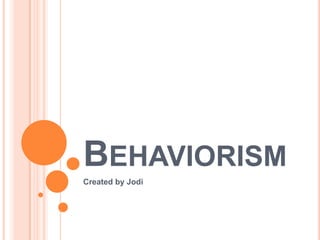
Eme2040 behaviorism
- 1. Behaviorism Created by Jodi
- 2. What Is Behaviorism? Behaviorism is the prediction and control of human behavior in which introspection and/or independent thinking play no essential part of its teaching methods Came into play during the industrial revolution of modernism Behaviorists recognize no dividing line between humans and animals Contributing behaviorists include Pavlov, Skinner and Bandura
- 3. Ivan Pavlov (1849-1936) Won Nobel Prize in Physiology in 1904 Used conditioning to teach dogs to salivate when he rang a bell Came up with Classic Conditioning, or the natural reflex that occurs in response to the stimulus
- 4. B.F. Skinner (1904-1990) Displayed Operant Conditioning, or learning that is controlled and-responsive patterns results in shaping behavior through the reinforcement of stimulus Skinner conducted an experiment with pigeon and rewarded them when they behaved properly , and even taught how to bowl in a specially conducted bowling alley
- 5. Albert Bandura (1925- ) Famous for his ideas on Social Learning or Social Cognitive Theory, which focuses on those motivational factors and self-regulatory mechanism that contribute to a person’s behavior Bandura believes that people learn through observation Television commercials show observational learning, or when something is watched and then the behavior is mimicked Recently, Bandura has focused on self-efficacy, or a personal observation about one’s perceived ability to feel, think and motivate oneself to learn
- 6. Classroom Implications Without Technology Teachers can use Behaviorism in classrooms through their behaviors. When they demonstrate how a child should perform or do an assignment, the children can mimic them (much like Bandura). Teachers can also reward the students for their behavior and work they do well in order to show behaviorism (much like Skinner). Much like with Pavlov’s dogs, teachers can have a routine in their classroom so the children can learn the behavior that comes next. For example, kindergarteners know that after they read a story it is nap time.
- 7. Classroom Implications With Technology For observation, much like Bandura, teachers can show videos of behaviors or projects that will be performed for the students to imitate Teachers can give PowerPoint Quizzes, much like the last assignment, and reward the students with an educational online computer game or another prize with the student answers a problem correctly Teachers can use Behaviorism with reinforcement by having the students go online to search something, writing down the source, and citing the website in order the for student to learn how to cite sources
- 8. Bibliography http://www.fadooda.com/media/1/20090902-Ivan_Pavlov.jpg http://www.cognitivedesignsolutions.com/images/BFSkinner2.jpg http://news.stanford.edu/news/2006/february22/gifs/ppl_bandura.jpg